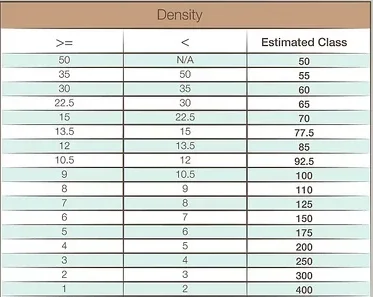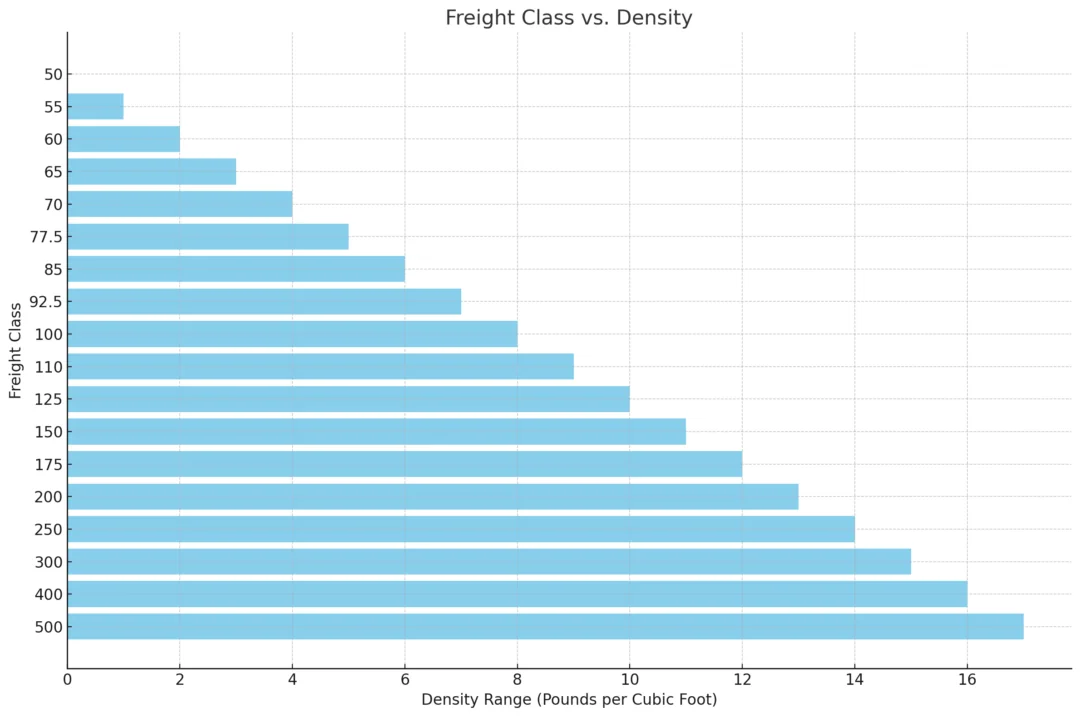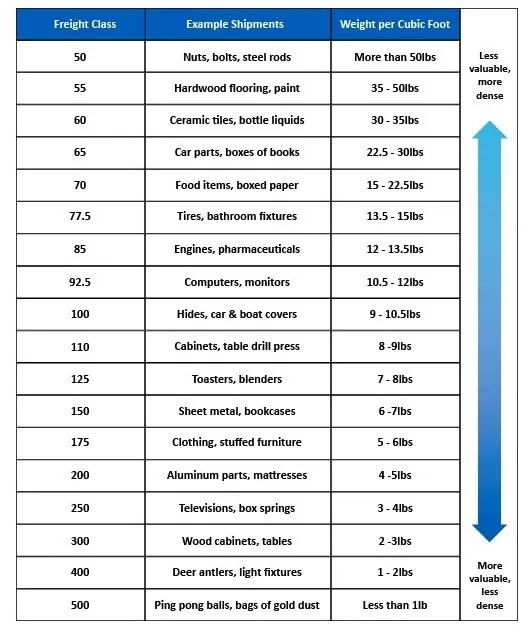
Freight Class
Understand and calculate your freight class for accurate shipping rates. With FreightCenter’s expert tools and guidance, finding the right class is simple—get started now to save on your next shipment!
Helpful Tools for Accurate Freight Class and Shipping Rates
Freight Class Calculator LTL Freight Services Freight Quote ToolUnderstanding Freight Class for Smarter Shipping
Freight class is a standardized system that categorizes freight shipments based on specific characteristics, ultimately impacting shipping rates and logistics planning. Determining the correct freight class is essential for accurate pricing, especially for Less-Than-Truckload (LTL) shipping, where costs are calculated based on the space your cargo occupies alongside other shipments. Understanding and accurately classifying your freight prevents unexpected charges and ensures a smooth shipping experience.
At FreightCenter, we simplify the freight classification process with tools and expert guidance to help you determine the suitable class for your shipment. Our freight class calculator makes identifying your shipment’s class easy based on factors like density, stowability, handling requirements, and liability. Whether you’re a small business or a large operation, FreightCenter’s resources and team of experts help you find the best shipping solutions and avoid reclassification fees, making your shipping more efficient and cost-effective.
Thousands of businesses trust FreightCenter to move their freight faster, smarter, and cheaper! From unbeatable rates to top-notch service, our customers are raving about their shipping success.
See why they keep coming back!
Award-Winning Service, Trusted by Shippers Everywhere!
- 2021, 2017 & 2016 Food Logistics’ Top Green Providers
- 2021 & 2018 Supply & Demand Chain Executives’ Pros to Know: Matthew Brosious
- 2020 & 2019 Top Food Logistics’ 3PL & Cold Storage Provider Award
- 2020 & 2019 Business Observer’s Top 500 Companies on the Gulf Coast
- 2020 & 2017 SmartWay® Transport Partner
- 2020 & 2017 Food Logistics’ Champions: Rock Stars of the Supply Chain
- 2020 Best of Palm Harbor Awards for Local Businesses
- 2017 Green Supply Chain Award from Supply & Demand Chain Executive
- 2017 Tampa Bay Business Journal Heroes at Work
- 2016, 2015, & 2012 Food Logistics Top 100 Software and Technology Providers
- 2013 Tampa Bay Business 100 by Tampa Bay Business Journal
- 2013 Top 100 Great Supply Chain Partners by SupplyChainBrain
- 2012 TIA Samaritan Award Honorable Mention
- 2012, 2011 & 2010 TBBJ Fast 50 Recipient
- 2013, 2011, & 2010 Diversity Business Top Businesses

What is Freight Class
Freight class is a standardized system established by the National Motor Freight Traffic Association (NMFTA) to categorize different types of freight based on specific characteristics. Primarily used for Less-Than-Truckload (LTL) shipping, freight class determines how a shipment is priced and handled. The system consists of 18 classes, ranging from Class 50 to Class 500, with lower classes assigned to dense, durable items and higher classes for lighter or more fragile goods. Choosing the correct freight class ensures accurate pricing, helps prevent unexpected reclassification fees, and facilitates smoother shipping operations.
Freight class is based on four main factors: density, stowability, handling, and liability. Density, calculated as weight per cubic foot, is often the most influential factor, as denser items are generally more accessible and more accessible mostly to transport. Stowability refers to how easily items can be stored with other freight, with irregularly shaped or hazardous goods potentially requiring special arrangements. Handling considers the freight’s ease or complexity, as fragile or oversized items may need special equipment or handling protocols. Lastly, liability relates to the shipment’s value, and shipments with higher-value or perishable goods potentially incur higher freight classes.
Understanding these factors is crucial for both shippers and carriers. Shippers can avoid costly delays and fees when freight is classified accurately, while carriers can better plan space and resources. FreightCenter’s FreightClass Calculator helps shippers determine the correct class for their shipment, ensuring they receive accurate rates and a seamless shipping experience. Whether you are freighting your own or are experienced in logistics, understanding and using the right Freicorrectlass is essential for cost-effective and efficient transportation.
How Freight Class Impacts Shipping Costs
Freight class plays a critical role in determining shipping costs, particularly for Less-Than-Truckload (LTL) shipments, where carriers calculate rates based on the class of each item on the truck. The freight class assigned to a shipment reflects how easily it can be handled, stored, and transported, with items in lower classes costing less than those in higher classes. This classification system helps carriers optimize space and resources, ultimately impacting the pricing structure.
Each freight class falls from Class 50 to Class 500, with lower classes assigned to dense, durable items (such as raw materials) and higher classes assigned to lighter, more delicate, or bulky goods. For instance, dense items like metal hardware might fall into Class 50, which is more economical. In contrast, fragile or bulky items like furniture may be assigned to higher classes, increasing the cost. Correctly classifying freight ensures accurate shipping costs; misclassification can lead to reclassification fees, unexpected charges, and delays in delivery.
Using the proper freight class helps avoid these additional charges and ensures a more efficient shipping process. At FreightCenter, our Freight Class Calculator and expert guidance make it easy to find the suitable class for your shipment, allowing you to secure the most accurate rates and avoid costly adjustments. By accurately determining and understanding your freight class, you gain better control over your shipping expenses and ensure a smoother experience from pickup to delivery.
Factors that Determine Freight Class

Density, Stowability, Handling, and Liability Explained
Freight class is determined by density, stowability, handling, and liability—four key factors that help categorize shipments and determine accurate shipping costs. Each factor reflects your freight’s unique characteristics, impacting its classification and shipping price. Here’s a closer look at each one:
Density
Density refers to the weight of the freight relative to its cubic volume (measured as pounds per cubic foot). To calculate density, divide the total weight of your shipment by its volume (length x width x height). High-density items are usually easier to transport and pack more efficiently, placing them in lower freight classes with lower rates. Lower-density items occupy more space per pound, resulting in higher freight classes and costs.
Stowability
Stowability considers how easily your freight can be arranged or stored with other shipments. Items with irregular shapes, hazardous classifications, or restrictions that prevent stacking often have higher freight classes due to the additional space or special handling they need. Freight that is stackable, regular in shape, and safe to transport alongside other items falls into lower classes.
Handling
Handling refers to the care and equipment needed to transport the freight safely. Items that require special handling due to fragility, size, or shape may be assigned a higher class as they involve additional time, attention, or equipment. Freight that is straightforward to handle, without special instructions, is usually classified lower, reducing shipping costs.
Liability
Liability measures the risk of transporting certain goods, factoring in their potential for damage, theft, or spoilage. High-value, perishable, or delicate items generally have higher freight classes to account for their increased liability. Durable or lower-risk goods, on the other hand, are assigned lower classes and cost less to ship.
By understanding how density, stowability, handling, and liability affect your freight class, you can accurately classify your shipment and avoid reclassification fees or delays. FreightCenter’s Freight Class Calculator and expert support make it easy to determine the right class for your shipment, helping you secure the best rates and a seamless shipping experience.
How to Calculate Freight Class
Calculating freight class accurately is essential to ensure your shipping rates are precise and to avoid unexpected fees or delays. Freight class is determined by four key factors—density, stowability, handling, and liability—with density often being the most significant—Here’s a step-by-step guide to help you calculate your freight class and determine the most cost-effective shipping solution.
Step 1: Calculate Density
To find your shipment density, measure the length, width, and height in inches. Multiply these dimensions to get the cubic volume in inches, then divide by 1,728 to convert the volume to cubic feet. Next, divide the weight of your shipment (in pounds) by its cubic feet. The result is your density, or weight per cubic foot, which is critical in determining freight class—generally, higher density results in a lower freight class and more cost-effective shipping.
Step 2: Evaluate Stowability
Stowability refers to how well your freight fits with other shipments. Irregularly shaped, hazardous, or oversized items may limit how easily they can be stacked or stored, leading to a higher freight class. Freight that’s available and easily fits within standard shipping containers is typically assigned a lower class.
Step 3: Assess Handling Requirements
Handling accounts for any special requirements your shipment may have. Fragile, delicate, or bulky items that need careful handling or specific equipment often fall into a higher freight class. For example, goods that require forklifts or special equipment will usually be more costly to ship.
Step 4: Determine Liability
Liability includes the risk of damage, theft, or spoilage of shipped items. High-value or perishable goods generally carry higher freight classes, requiring added protection and care. Lower-liability items, such as durable raw materials, tend to have lower classes and are less costly to ship.
Using a Freight Class Calculator
If you’re curious about the classification, the FreightCenter Freight Class Calculator simplifies the process by calculating freight class based on your inputted weight, dimensions, and other factors. This tool provides an accurate class, helping you avoid reclassification fees and ensuring that your shipping costs align with your budget.
With FreigFreightCenter’s resources and support, calculating freight class becomes a straightforward part of your shipping process, giving you the peace of mind that your shipment is accurately priced and prepared for efficient transport.
Common Mistakes in Freight Classification
One common mistake in freight classification is **underestimating the size and weight of your shipment**. When you don’t measure your items accurately, you might classify them in a lower freight class than they belong to. This can lead to unexpected costs later, as the shipping company might reclassify your shipment to a higher class after they measure it themselves. To avoid this, using a reliable scale and measuring tools is essential to get the correct dimensions and weight before determining freight class.
Another mistake people often make is **not considering the unique handling needs of their shipment**. Some items, such as fragile goods or hazardous materials, require extra care during loading and unloading. If you overlook these special requirements, you might classify your shipment too low, resulting in additional fees or even damage to your goods. Consider how your items must be handled during transit and factor this into your chosen freight class.
Finally, many shippers make the mistake of **ignoring the density of their items**. Density is a key factor in determining freight class, and it is calculated by dividing the weight by the volume of the volume. Your shipment is bulky but light; it will likely belong to a higher freight class, meaning shipping will cost more. Not considering density can lead to misclassification and unexpected charges. Calculate the density accurately and choose the correct freight class based on that information to avoid this mistake.
Explore common freight classes and their descriptions to better understand shipping categories. Learn how Class 50 to Class 500 impact rates and handling for accurate freight classification.
High-density, durable items like bricks, tiles, and raw materials; ideal for lower-cost shipping due to compactness.
Bulk goods like automotive parts, lumber, and rubber materials; cost-effective and stowable for streamlined transport.
Sturdy items such as cement, plastics, and canned goods; dense and economical for efficient shipping.
Materials like sheet metal, furniture components, and hardware; versatile for various industries with mid-range freight costs.
Common products like machinery parts, books, and car parts; moderately priced for reliable shipping.
Durable goods such as paint, appliances, and furniture parts; suited for safe handling and flexible storage.
Electronics, boxed furniture, and metal tools; higher class to protect value and quality during transit.
Specialized items like fragile electronics and textiles; priced for careful handling and secure transport.
Plastic goods, wood furniture, and household items; a balanced option for affordability and care.
Plastic goods, wood furniture, and household items; a balanced option for affordability and care.
Mattresses, bicycles, and boxed electronics; shipping-friendly with rates reflecting light handling needs.
Fragile items like refrigerators, rugs, and glassware; requires careful transport with moderate freight costs.
Mid-sized goods like ladders, durable plastics, and home products; priced for flexibility and secure shipping.
Lightweight items such as paper products, insulated containers, and decor; higher class to accommodate delicate handling.
High-liability goods like fragile furniture, sensitive machinery, and electronics; premium rates for maximum protection.
Bulky or high-value items like antiques, artwork, and large electronics; designed for specialized handling and highest care during transit.


Tools to Help Determine Freight Class
Freight Class FAQs
Q. What is freight class?
Freight class is a classification system used to categorize shipments based on factors like size, weight, density, and handling requirements. It helps determine shipping costs.
Q. Why is freight class important?
Freight class is important because it directly affects the cost of shipping. Accurate classification ensures you are charged correctly and that your shipment is handled properly.
Q. How is freight class determined?
Freight class is determined by evaluating the shipment’s density (weight and volume), stowability, handling needs, and liability. Each of these factors plays a role in assigning the appropriate class.
Q. What are the different freight classes?
There are 18 standard freight classes, ranging from Class 50 to Class 500. Lower classes generally indicate denser, less expensive-to-ship items, while higher classes are for lighter, bulkier, or more fragile goods.
Q. How do I calculate freight class?
To calculate freight class, measure the dimensions and weight of your shipment, calculate its density, and then refer to a freight class chart to find the appropriate class based on the density and other factors.
Q. What happens if I choose the wrong freight class?
If you choose the wrong freight class, your shipment could be reclassified by the carrier, which might result in additional charges or delays. It’s important to get the classification right to avoid these issues.
Q. Can freight class affect delivery times?
While freight class primarily affects cost, it can also influence how your shipment is handled, which may indirectly impact delivery times, especially for items that require special handling.
Q. Are there different freight classes for different types of goods?
Yes, different types of goods can fall into different freight classes based on their characteristics. For example, fragile items, hazardous materials, or goods that require special handling are often in higher freight classes.
Q. Do all carriers use the same freight class system?
Yes, the freight class system is standardized across the U.S. by the National Motor Freight Traffic Association (NMFTA), so all carriers use the same classifications.
Q. How can I avoid mistakes in freight classification?
To avoid mistakes, always measure and weigh your shipment accurately, consider all factors like stowability and handling, and use a reliable freight class chart or consult with your carrier.
Q. What is the difference between freight class and NMFC code?
Freight class is a broad classification based on the shipment’s characteristics, while the NMFC (National Motor Freight Classification) code is a specific code that corresponds to a particular type of commodity and its freight class.
Q. Can freight class affect insurance costs?
Yes, higher freight classes, which indicate more valuable or fragile items, may have higher insurance costs due to the increased risk of damage or loss.
Q. Is freight class the same for all types of shipping?
Freight class is primarily used for less-than-truckload (LTL) shipping. Other types of shipping, like full truckload (FTL) or parcel shipping, may use different pricing models.
Q. Can I change the freight class after shipping?
Once a shipment is in transit, it’s difficult to change the freight class. Any adjustments usually need to be made before the shipment is picked up.
Q. How often do freight classes change?
Freight classes don’t change frequently, but the NMFTA occasionally updates classifications based on industry standards and changes in shipping practices.
Q. What should I do if I’m unsure of my freight class?
If you’re unsure of your freight class, consult with your carrier or use an online freight class calculator. Providing accurate dimensions and weight will help ensure you select the correct class.
Q. Are there penalties for incorrect freight class?
Yes, using an incorrect freight class can lead to reclassification charges, penalties, or delays. It’s crucial to classify your freight accurately.
Q. Does freight class impact fuel surcharges?
Freight class can influence overall shipping costs, including fuel surcharges, especially if the shipment is reclassified or if its characteristics require different handling than initially estimated.
Q. Can a freight broker help with freight class?
Yes, freight brokers such as FreightCenter.com can assist with determining the correct freight class, helping to ensure that your shipment is classified accurately and cost-effectively.
Q. How does stowability affect freight class?
Stowability refers to how easily a shipment can be stored with other freight. Items that are difficult to stack or that take up more space might have a higher freight class, leading to higher shipping costs.
3 advantages of using FreighCenter to get Freight Class

Accuracy and Efficiency:
FreightCenter provides tools and resources that simplify the process of determining the correct freight class for your shipment. This accuracy ensures that you receive the most appropriate shipping rates and avoid costly reclassifications or delays.

Expert Assistance:
FreightCenter's platform connects you with shipping experts who can help you correctly classify your freight. If you're unsure about your shipment's class, their support team is available to guide you, ensuring your freight is handled correctly from start to finish.

Convenient All-in-One Service:
FreightCenter not only helps you determine your freight class but also allows you to compare rates from multiple carriers and book your shipment all in one place. This streamlined service saves you time and effort, making the entire shipping process more convenient and efficient


